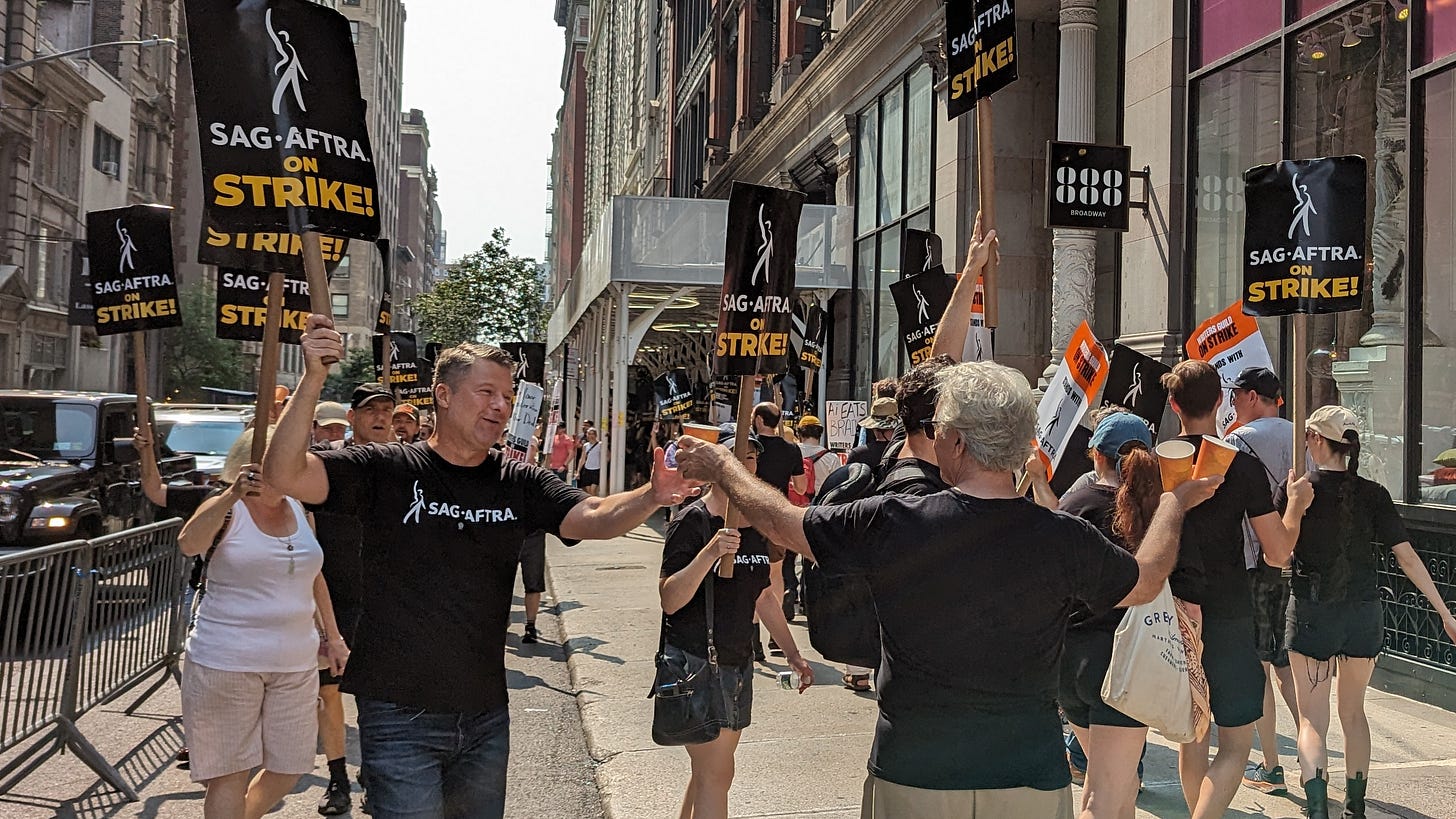Only 2% of Hollywood Actors are Making It Now, Claims Disney Channel Star
In a candid podcast appearance, former Disney Channel standout Alyson Stoner pulled back the curtain on the brutal realities of Tinseltown, revealing that the glitz and glamour often mask a harsh financial struggle for most performers. Drawing from personal experiences as a child star in hits like Camp Rock and Cheaper by the Dozen, Stoner highlighted a staggering statistic: only a tiny fraction of actors can actually sustain themselves through acting alone.
Here's the TLDR...
Alyson Stoner's Wake-Up Call: The ex-Disney star claims just 2% of actors make a full living from the craft, citing a UK study and sharing personal tales of hidden costs and unpaid hustle.
Hollywood's Unemployment Crisis: Post-2023 strikes, actor joblessness hovers around 90%, with production still reeling in 2025.
Strikes' Lingering Shadow: The dual WGA and SAG-AFTRA walkouts cost billions and slashed jobs, but scored wins like AI safeguards.
Streaming's Deflated Bubble: Fewer shows, tighter budgets—streaming's gold rush is over, leaving thousands scrambling for work.
AI Looming Large: From de-aged stars to cloned voices, artificial intelligence poses an "existential threat" to actors' livelihoods.
Success Stories Shine Through: Not all Mouse House alums fade—stars like Zendaya and Ryan Gosling prove breakout careers are possible.
What Alyson Stoner Revealed About the Hidden Costs of Fame
Alyson Stoner, who first danced into the spotlight at age six in Missy Elliott's iconic "Work It" video before becoming a Disney staple, didn't mince words during their chat on Yahoo Finance's Living Not So Fabulously podcast. Promoting their upcoming book Semi-Well-Adjusted Despite Literally Everything, Stoner delved into the financial pitfalls that plague performers, even those with early success.
"Only 2% of actors are able to earn a living solely from acting. That means 98% of us have other jobs just to make ends meet," Stoner stated, referencing a study from Queen Mary University of London. They painted a picture of an industry where unpaid promotional work and publicity demands dominate schedules. "Unpaid work and publicity are really the backbone of the creative industry," Stoner explained, noting that such obligations "easily filled more than half of my schedule."
The financial drain doesn't stop there. Stoner broke down the math: after booking a gig, commissions to agents and managers devour chunks of earnings—up to 35% in their childhood case—leaving pennies on the dollar after taxes and expenses.
"I had to earn two to three times my living expenses just to make enough after commissions and taxes and business expenses to pay rent," they shared. This relentless grind warped their worldview, tying self-worth to earning potential from a young age. "The entertainment industry teaches children that their worth is tied to their earning potential," Stoner reflected, adding that it created "a warped understanding of relationships where love and belonging and financial value become intertwined."
Today, Stoner balances voice acting gigs with a role as a mental health practitioner, emphasizing the freedom of not relying solely on Hollywood. "By not relying entirely on Hollywood to sustain themselves financially, they recognized, 'I actually get to trim so many expenses off my budget.'" Their story underscores a broader truth: fame doesn't guarantee fortune, and many stars end up moonlighting to survive.
The Numbers Behind the Struggle: Fact-Checking the 2% Claim
Stoner's cited study from Queen Mary University aligns with grim industry data. While the exact research pegs the success rate at a mere 2%, broader stats paint an even bleaker picture.
According to SAG-AFTRA, only about 12% of members earn more than $1,000 annually from acting, with unemployment rates hitting 90% in recent years. The U.S. Bureau of Labor Statistics reports the median hourly wage for actors at $23.33 as of May 2024, with little job growth projected through the decade.
In 2025, Hollywood's job market remains stagnant. Entertainment employment in Los Angeles is down 25% from its 2022 peak, per a report from Otis College of Art and Design. Shoot days plummeted from over 6,800 in early 2024 to just 5,295 in the first quarter of 2025, signaling a slow recovery.
California's slice of national motion picture jobs has shrunk to 27%, a far cry from its 1990s dominance at 46%. As one Reddit user lamented, "Employment for actors has been way down for the past 2 years and may or may not recover in 2025."
How the 2023 Double Strikes Deepened Hollywood's Unemployment Woes
The 2023 Writers Guild of America (WGA) and SAG-AFTRA strikes—lasting months and halting productions—exacerbated these issues. Dubbed the biggest industry disruption since COVID-19, the walkouts cost an estimated $5–6.5 billion nationwide, with Southern California alone losing billions in economic activity. Payroll in motion picture and sound recording dropped by 6,700 jobs in mid-2023, a 4.7% decline.
One year on, the scars linger.
"It's still too early to judge the overall effects," noted industry analysts, but gains included higher minimums (7% for actors, 3–5% for writers), better streaming residuals, and AI protections. Yet, many workers regret the action amid ongoing job scarcity.
A YouTube video titled "Will Hollywood Survive 2025? Some Workers REGRET the Strikes!" captures the sentiment: "Many are still unemployed." Film and TV unemployment spiked to 12.5% in late 2024, nearly triple the norm.
The Bursting Streaming Bubble: Fewer Gigs, Tighter Wallets
Once hailed as Hollywood's savior, streaming's explosive growth has fizzled. By 2025, production hasn't rebounded, with shows and films slashed by 40% from peak levels. Services like Netflix project ad revenue doubling but are cutting budgets and originals to chase profits.
"The TV Bubble Popped," declares one analyst, pointing to halved output in the first half of 2025.
This contraction hits actors hard. "Hollywood faces uncertainty as streaming struggles shape entertainment industry's future," with reduced new content and lower budgets. As prices rise for subscribers and studios pivot, the era of endless streaming cash is ending, per The Economist.
The AI Threat: An Existential Challenge for Performers
Artificial intelligence adds another layer of dread. "AI Begins Dismantling Hollywood's Grip On The Silver Screen," warns Forbes, as tools de-age stars like Tom Hanks in real-time or clone voices for dubbing. The 2023 strikes secured "historic protections" against AI, but fears persist. "This is an existential threat," says filmmaker Justine Bateman, echoing actors' worries about deepfakes and job displacement.
In 2025, voice actors push back against cloning tech, while unions refine contracts to curb AI in commercials. Protests continue, with over 150,000 performers striking in 2023 partly over AI fears. As one Reddit thread ponders, *"What will happen to the movie industry and actors once AI can generate entire films?"
Not All Disney Dreams Fade: Stars Who Made It Big Post-Mouse House
Amid the gloom, some Disney Channel vets have soared. Zendaya, from Shake It Up, now dominates with Euphoria, Dune, and Marvel's Spider-Man flicks. Ryan Gosling, an early Mickey Mouse Club member, earned Oscar nods for Barbie and La La Land.
Selena Gomez transitioned from Wizards of Waverly Place to billionaire status via music, acting in Only Murders in the Building, and her Rare Beauty brand. Miley Cyrus shed Hannah Montana for Grammy-winning tunes and roles in Black Mirror. Demi Lovato, of Camp Rock fame, built a powerhouse music career while advocating for mental health.
Others include Zac Efron (High School Musical to The Iron Claw), Jenna Ortega (Stuck in the Middle to Wednesday), and Olivia Rodrigo (from High School Musical: The Series to pop stardom). These outliers show talent and timing can defy the odds.
Hollywood's challenges—strikes, streaming slumps, AI—paint a tough picture for aspiring actors in 2025. Yet, as Stoner's resilience proves, diversifying beyond the screen might be the real key to "making it."
Hat Tips
Former Disney star Alyson Stoner details hidden costs of working in Hollywood: https://www.aol.com/finance/former-disney-star-alyson-stoner-175413718.html
Hollywood Acting Industry Statistics 2025: https://bernardhiller.com/hollywood-acting-industry-statistics/
Hollywood Has Not Recovered Jobs Lost During Strikes, Report Says: https://www.nytimes.com/2025/03/27/movies/hollywood-jobs-lost-strikes.html
Actors : Occupational Outlook Handbook: https://www.bls.gov/ooh/entertainment-and-sports/actors.htm
Even before the L.A. fires, Hollywood jobs were hard to find: https://www.latimes.com/entertainment-arts/business/story/2025-01-16/2024-was-a-tough-year-for-hollywood-jobs-but-there-are-some-bright-spots
Film industry job losses, the bankruptcy of the unions and the fight: https://www.wsws.org/en/articles/2025/04/23/euwa-a23.html
LA's streaming gold rush is over. Film and TV workers have been left: https://sherwood.news/business/hollywood-worker-strikes-media-streaming-impacts/
The Economic Impact of the Hollywood Writers and Actors Strikes: https://camoinassociates.com/resources/economic-impact-of-the-hollywood-writers-and-actors-strikes/
Labor Unions in the Entertainment Industry: WGA and SAG-AFTRA: https://www.scirp.org/journal/paperinformation?paperid=134071
Comparing the WGA and SAG-AFTRA Agreements: https://www.romanolaw.com/post-strike-insights-comparing-the-wga-and-sag-aftra-agreements/
The TV Bubble Popped…: https://entertainmentstrategyguy.com/2025/07/31/the-tv-bubble-popped/
Hollywood industry in crisis after strikes, streaming wars: https://www.bbc.com/news/articles/cj6er83ene6o
Streaming slows to a trickle in 2025: https://www.economist.com/the-world-ahead/2024/11/19/streaming-slows-to-a-trickle








